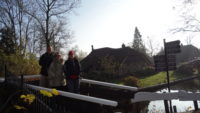 Meredith relies heavily on the Rick Steves brand of travel books to plan these vacations. I like using the internet, which allows me to occasionally go “OR,” or Off-Rick. One of the places I found in my searches that looked lovely was Giethoorn, a small village carved out of a peat swamp where the traditional center of the town remains largely unchanged – no motor traffic (other than five-mph boats on the many canals), and the center is now a protected World Heritage site. I really wanted to see it.
Meredith relies heavily on the Rick Steves brand of travel books to plan these vacations. I like using the internet, which allows me to occasionally go “OR,” or Off-Rick. One of the places I found in my searches that looked lovely was Giethoorn, a small village carved out of a peat swamp where the traditional center of the town remains largely unchanged – no motor traffic (other than five-mph boats on the many canals), and the center is now a protected World Heritage site. I really wanted to see it.
This created a problem; to get there by public transportation takes at least two hours each way, which is a long time for a day trip. It is around ninety minutes by car, which is about as far as I am willing to go for a single site in a day. So the obvious thing to do was to hire a local guide. I could have rented a car more cheaply, or even gotten an Uber for less money, but Mer and I have always enjoyed the guides we have hired on past trips. They are guides for a reason – they know things about the sites that are otherwise hard to pick up, or they know places not on the beaten paths, and they take care of the driving.
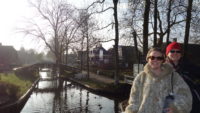 Enter Cherry, of Cherry’s Travel. Cherry is originally from Hong Kong, but has lived in the Netherlands for twelve years. She has lived all over the world, and loves travel. She put together a private tour for us, with her and a driver, on only about sixteen hours’ notice. I did not book things until Thursday, as I was keeping an eye on the weather, which was cool but sunny today. Cherry agreed to take us to Giethoorn, then to the all-in-one-all-things-Dutch village/site of Zaanse Schans, and finish off at the sort-of seaside town of Volendam. She said it would be a long day, but it would get us a Dutch highlights tour all in one day.
Enter Cherry, of Cherry’s Travel. Cherry is originally from Hong Kong, but has lived in the Netherlands for twelve years. She has lived all over the world, and loves travel. She put together a private tour for us, with her and a driver, on only about sixteen hours’ notice. I did not book things until Thursday, as I was keeping an eye on the weather, which was cool but sunny today. Cherry agreed to take us to Giethoorn, then to the all-in-one-all-things-Dutch village/site of Zaanse Schans, and finish off at the sort-of seaside town of Volendam. She said it would be a long day, but it would get us a Dutch highlights tour all in one day.
We got to Giethoorn around 10:30, and booked a canal boat tour for 11:30. We used the time in between to wander the village. The town has a public walking path because most of the houses are on small islands, and the paths and bridges to them are private. The path takes you past boat companies and restaurants, and to the church, where you can walk north or south. We went south, admiring the thatched-roof houses and the many many many bridges across the many many many canals – the town has over 150 bridges for just 2,600 residents. The canals, and the large lake next to the town, were all created by farming peat for fuel. As the peat was shallow, all the waterways (including the lake) are only about three feet deep.
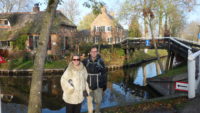 Traveling off-season has challenges – not everything is open, and it can be cold (it was a high of forty-four today), but it has advantages too. We had the town largely to ourselves. While we saw five or six tourists on small boats in the canals, I do not remember seeing any obvious tourists on our walk, which was very peaceful and beautiful. When we got back for our boat tour, it ended up being a private tour – four of us and the pilot in a boat that can hold fifty people. It probably was not good for the boat company, but it was good for us. Other boats we saw while we were there had more people in them, but we had our own.
Traveling off-season has challenges – not everything is open, and it can be cold (it was a high of forty-four today), but it has advantages too. We had the town largely to ourselves. While we saw five or six tourists on small boats in the canals, I do not remember seeing any obvious tourists on our walk, which was very peaceful and beautiful. When we got back for our boat tour, it ended up being a private tour – four of us and the pilot in a boat that can hold fifty people. It probably was not good for the boat company, but it was good for us. Other boats we saw while we were there had more people in them, but we had our own.
After the boat tour, which also went out on the lake, we grabbed a quick lunch, and then walked the northern part of the town. Again, we had it largely to ourselves, although we did run into a group of eight or so twenty-ish-year-old guys going into a restaurant, but I could not tell if they were tourists or locals. Giethoorn was a hit with us, and I would happily go back when it was warmer so I could spend more time wandering the town or renting an electric boat to take out on the lake.
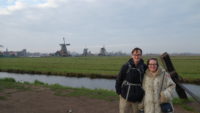 Going to and coming from Giethoorn took us through a huge area of reclaimed land – the Dutch are really good at building dikes, and turned their Zuiderzee (South Sea) into a large freshwater lake by building a twenty-two-mile dike across the mouth to the Atlantic. Then they built more dikes to reclaim dry land from some of the lake. The land now sits below the lake level, as does much of the country – two thirds of the Netherlands is below sea level. Driving along and seeing the water within just a couple of feet of the top of the dike with towns below that level on the other side is eye-opening. Mer put it well when she said that the Netherlands looked to be one good rain away from flooding.
Going to and coming from Giethoorn took us through a huge area of reclaimed land – the Dutch are really good at building dikes, and turned their Zuiderzee (South Sea) into a large freshwater lake by building a twenty-two-mile dike across the mouth to the Atlantic. Then they built more dikes to reclaim dry land from some of the lake. The land now sits below the lake level, as does much of the country – two thirds of the Netherlands is below sea level. Driving along and seeing the water within just a couple of feet of the top of the dike with towns below that level on the other side is eye-opening. Mer put it well when she said that the Netherlands looked to be one good rain away from flooding.
We drove back around Amsterdam and went north of the city, to the tourist-focused site/town of Zaanse Schans. It is a tourist trap, with five relocated and working windmills, a clog-making shop, a cheese-making shop, and a cute village where no one lives (they are shops), but the tourist area is surrounded by cute homes where people really do live, so the whole area is open to people to wander around in, and most stores give demonstrations for free so that they get potential customers into the store.
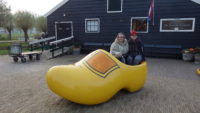 We got to see the five windmills, although not so closely as I would normally like, as we were a little pressed for time. We got to see an excellent clog-making demonstration by a man with flawless English, who then did the entire demonstration in Chinese for the group after us. It used to take two or three hours to carve a wooden shoe, whereas the “new” (eighty-year-old) machines he demonstrated could make a shoe in five minutes. Why wooden shoes? They last a long time and are waterproof, which is important in a country where water is everywhere.
We got to see the five windmills, although not so closely as I would normally like, as we were a little pressed for time. We got to see an excellent clog-making demonstration by a man with flawless English, who then did the entire demonstration in Chinese for the group after us. It used to take two or three hours to carve a wooden shoe, whereas the “new” (eighty-year-old) machines he demonstrated could make a shoe in five minutes. Why wooden shoes? They last a long time and are waterproof, which is important in a country where water is everywhere.
We went on to a just-us cheese-making demonstration given by a cheerful young woman. She explained that their young cheese was about a month old, and old cheese was aged one or even two years. We wandered the shop and then out into the old village area, before getting in the car to go to Volendam.
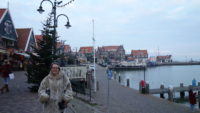 I keep wanting to call Volendam a seaside town, but it technically is not one anymore. It was on the sea until the early twentieth century, when the sea dike was built. Now, Volendam is on a huge lake, but still looks like a seaside town. In fact, it reminded both Mer and me of Rockland, Maine, where Mer’s grandfather lived. In Voldendam, we walked along the cute street facing the lake and got a private demonstration of how to make stroopwafels, with Meredith assisting in the process. Stroopwafels are a Dutch dessert for which very thin waffles are cut in half and filled with caramel, and then put back together. They are delicious. It turns out the fresh, warm versions are drool-worthy. Mer and I picked up chocolate-covered stroopwafels and ate them looking out at the lake.
I keep wanting to call Volendam a seaside town, but it technically is not one anymore. It was on the sea until the early twentieth century, when the sea dike was built. Now, Volendam is on a huge lake, but still looks like a seaside town. In fact, it reminded both Mer and me of Rockland, Maine, where Mer’s grandfather lived. In Voldendam, we walked along the cute street facing the lake and got a private demonstration of how to make stroopwafels, with Meredith assisting in the process. Stroopwafels are a Dutch dessert for which very thin waffles are cut in half and filled with caramel, and then put back together. They are delicious. It turns out the fresh, warm versions are drool-worthy. Mer and I picked up chocolate-covered stroopwafels and ate them looking out at the lake.
We finished walking the main street and then hustled back to the car to get out of the gusting wind, which was now very cold with the sun’s going down. We rode back into town, getting home about 5:30.
I thought that was to be the end of the touring day. Since we had eaten late, we headed out around 7:00 to get light fare from a local supermarket. However, when we were halfway to the market, my eye was caught by a woman playing a piano in a restaurant, so we crossed the street to look at the menu. It turned out to be an Argentinian eatery, so it was mostly grilled meats. We decided were were all okay with that, and we went in for what turned out to be our favorite meal of the week. If you are ever in Amsterdam, check out La Casona near the Prinsengracht canal. Our meal was a fitting celebratory end to an excellent week in Amsterdam and environs.
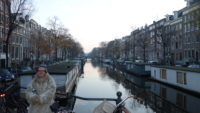 I loved this trip. The city is beautiful, with the old buildings and all the canals. The museums are top-notch. Getting lost is easy, but you don’t really mind in a city like this. The people with whom we interacted were all friendly, and many were outright charming. We squeezed in a visit to a castle and a canal-rich village. We saw heroic World War II sites and got to The Hague, remarkable for at least having an article in its name.
I loved this trip. The city is beautiful, with the old buildings and all the canals. The museums are top-notch. Getting lost is easy, but you don’t really mind in a city like this. The people with whom we interacted were all friendly, and many were outright charming. We squeezed in a visit to a castle and a canal-rich village. We saw heroic World War II sites and got to The Hague, remarkable for at least having an article in its name.
Lord willing, we’ll be back. When it is warmer. These Thanksgiving trips, if they continue, need to look south.